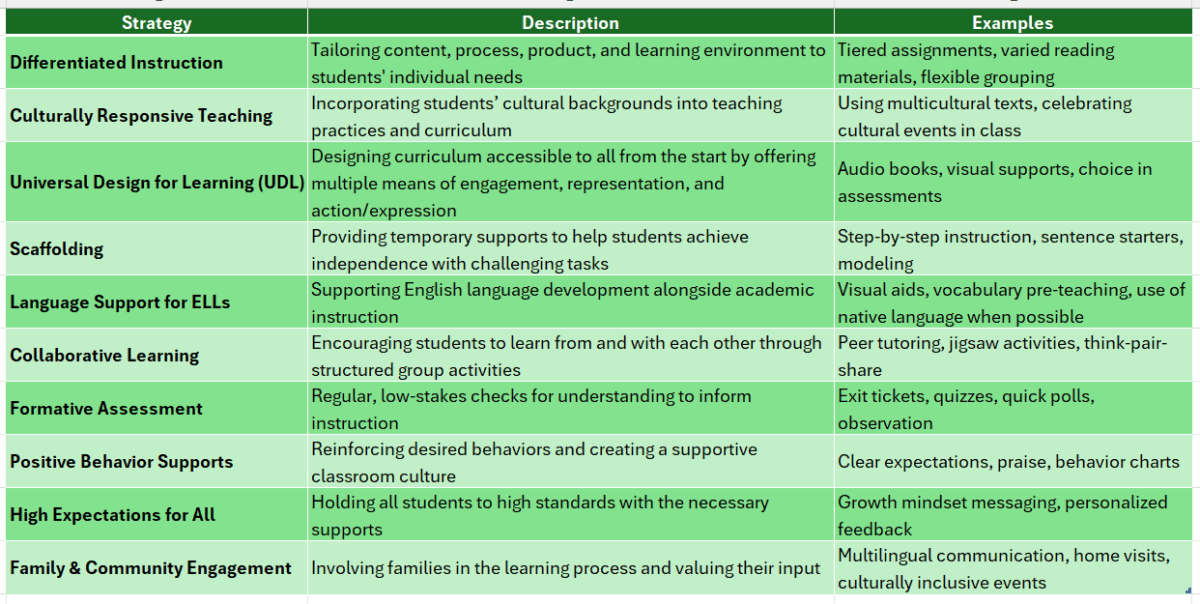
Teaching diverse learners is crucial in today’s classrooms. Every student brings unique experiences and backgrounds, which can enrich the learning environment. By focusing on equity, educators can ensure that all students, regardless of their differences, have the opportunity to succeed. This approach not only benefits individual learners but also strengthens the entire classroom community.
The Role of Community-Based Instruction
Community-based instruction is a powerful strategy for teaching diverse learners. It connects classroom lessons to real-world experiences, making learning relevant and engaging. For instance, students can explore local businesses or community centers, helping them understand how their education applies outside school. This method fosters inclusivity and encourages collaboration among students from different backgrounds.
Embracing Standards-Based Instruction
Standards-based instruction is another essential strategy. It focuses on clear learning goals that all students should achieve. By using differentiated teaching methods, educators can cater to various learning styles and needs. This ensures that every student can access the curriculum, promoting equity and helping them reach their full potential.
Study smarter, not harder—Enroll online today!
What Are the Key Challenges in Teaching Diverse Learners?

Teaching diverse learners is essential in today’s classrooms, where students come from various backgrounds and abilities. Understanding the unique challenges teachers face can help create a more equitable learning environment. By addressing these challenges, educators can better support all students, ensuring everyone has the opportunity to succeed.
Understanding Individual Needs
Every student has different strengths and weaknesses. Teachers must identify these individual needs to tailor their instruction. This can be tricky, especially in a classroom with many diverse learners. Community-based instruction can help by connecting lessons to real-life experiences, making learning more relevant.
Balancing Standards-Based Instruction
While it’s important to meet educational standards, teachers also need to adapt their methods. Standards-based instruction often focuses on uniformity, which can overlook the unique needs of diverse learners. Finding a balance between these two approaches is crucial for promoting equity in classrooms.
Strategies for Creating an Inclusive Classroom Environment
Teaching diverse learners is essential for creating equitable classrooms where every student can thrive. When educators embrace different backgrounds, abilities, and learning styles, they foster an environment that values each student’s unique contributions. This approach not only enhances learning but also builds a sense of community among students.
Embrace Community-Based Instruction
- Connect Learning to Real Life: Use local resources and community events to make lessons relevant. This helps students see the value in what they are learning.
- Involve Families: Encourage family participation in school activities. This strengthens relationships and supports diverse learners by making education a community effort.
Implement Standards-Based Instruction
- Set Clear Goals: Establish clear learning objectives that cater to all students. This ensures everyone knows what they are working towards.
- Differentiate Assessments: Use various assessment methods to accommodate different learning styles. This allows all students to demonstrate their understanding in ways that suit them best.
How Can Culturally Responsive Teaching Enhance Equity?
Teaching diverse learners is essential in today’s classrooms. Every student brings unique backgrounds, experiences, and perspectives. By embracing these differences, educators can create an environment where all students feel valued and included. This approach not only promotes equity but also enhances learning outcomes for everyone.
Culturally responsive teaching focuses on recognizing and respecting students’ cultural backgrounds. Here are some strategies to enhance equity:
- Community-based instruction: Connect lessons to students’ communities, making learning relevant and engaging. This helps students see the value in their education and encourages participation.
- Standards-based instruction: Align teaching methods with educational standards while considering diverse learning needs.
This ensures that all students have access to the same high-quality education, regardless of their backgrounds. By implementing these strategies, teachers can create a more equitable classroom. When students feel understood and supported, they are more likely to succeed academically and socially.
The Role of Differentiated Instruction in Supporting Diverse Learners
Teaching diverse learners is crucial for creating equitable classrooms where every student can thrive. By adopting various teaching strategies, educators ensure that all students, regardless of their backgrounds or abilities, have the chance to succeed. This approach fosters inclusivity and enriches the overall learning environment.
Differentiated instruction tailors teaching methods to meet the diverse needs of students. This strategy addresses individual learning styles and paces, making lessons more accessible. Key aspects include:
- Community-based instruction: Teaching in real-world settings helps students connect classroom learning to their lives.
- Standards-based instruction: Aligning lessons with educational standards ensures that all students learn essential skills while allowing for personalized approaches.
Incorporating differentiated instruction not only supports diverse learners but also fosters a sense of belonging. When students feel their unique needs are acknowledged, they are more likely to engage actively in their education, ultimately leading to a richer, more equitable classroom experience for all.
Utilizing Technology to Bridge Gaps in Learning
Teaching diverse learners is essential in creating equitable classrooms where every student can thrive. By embracing various strategies, educators can ensure that all students, regardless of their backgrounds or abilities, receive the support they need to succeed. One powerful tool in this endeavor is technology, which can bridge gaps in learning and enhance engagement.
Personalized Learning Experiences
- Adaptive Learning Software: Programs that adjust to each student’s pace and level can make learning more accessible.
- Interactive Tools: Using apps and games can motivate students and cater to different learning styles, making lessons more enjoyable.
Community-Based Instruction
Integrating community resources into lessons can provide real-world context. For instance, field trips or local projects can help students connect classroom learning to their lives. This approach not only enriches standards-based instruction but also fosters a sense of belonging and relevance in diverse learners’ education.
Collaborative Learning: A Strategy for Promoting Equity
Teaching diverse learners is essential for creating equitable classrooms where every student feels valued and included. By implementing effective strategies, educators can ensure that all students, regardless of their backgrounds or abilities, have the opportunity to succeed. One powerful approach is collaborative learning, which fosters teamwork and mutual respect among students.
Benefits of Collaborative Learning
- Encourages Peer Support: Students learn from each other, helping those who may struggle with certain concepts.
- Builds Communication Skills: Working together enhances students’ ability to express their ideas clearly.
- Fosters Inclusion: Diverse groups promote understanding and appreciation of different perspectives.
Incorporating community-based instruction within collaborative learning can further enhance equity. This approach connects classroom lessons to real-world experiences, making learning relevant and engaging. Additionally, standards-based instruction ensures that all students meet the same learning goals, regardless of their starting point. By blending these strategies, educators can create a rich, supportive environment that celebrates diversity and promotes success for every learner.
Study smarter, not harder—Enroll online today!
Assessing Diverse Learners: Best Practices for Fair Evaluation
Teaching diverse learners is crucial for fostering equitable classrooms where every student can excel. By embracing various backgrounds, abilities, and learning styles, we create an environment that values each student’s unique contributions, enhancing their learning experience and preparing them for a diverse world.
Understand Individual Needs
- Community-based instruction: This method connects lessons to real-life experiences, allowing teachers to assess students in familiar settings and better understand their strengths and challenges.
- Standards-based instruction: Aligning assessments with clear standards ensures fair evaluation for all students, focusing on what they should know and be able to do, thus promoting equity.
Use Varied Assessment Methods
- Multiple formats: Incorporate tests, projects, and presentations to accommodate different learning styles, enabling students to demonstrate their knowledge effectively.
- Ongoing feedback: Regular check-ins allow teachers to adjust instruction and support, ensuring all learners progress in a supportive atmosphere.
How Can Educators Foster a Growth Mindset in All Students?
Teaching diverse learners is essential in creating equitable classrooms where every student can thrive. By recognizing and valuing the unique backgrounds and abilities of each student, educators can implement strategies that promote inclusivity and foster a growth mindset. This approach not only benefits individual learners but also enriches the entire classroom community.
Embrace Community-Based Instruction
Community-based instruction allows students to learn in real-world settings. This method helps diverse learners connect classroom concepts to their lives. By engaging with their communities, students can see the relevance of their education, which boosts motivation and confidence.
Implement Standards-Based Instruction
Standards-based instruction ensures that all students meet specific learning goals. By tailoring lessons to different learning styles, educators can support diverse learners effectively. This approach encourages students to take ownership of their learning, fostering resilience and a growth mindset.
Discover How Scholarship.Education Supports Educators in Teaching Diverse Learners
Teaching diverse learners is essential in today’s classrooms. Every student comes with unique backgrounds, experiences, and learning styles. By promoting equity, educators can ensure that all students have the opportunity to succeed. At Scholarship.Education, we believe that effective strategies can make a significant difference in how diverse learners thrive.
To support educators, we focus on two key approaches: community-based instruction and standards-based instruction. These methods help create an inclusive environment where every student feels valued. Community-based instruction connects learning to real-life experiences, making lessons more relatable and engaging for all students.
Key Strategies for Promoting Equity
- Community-Based Instruction: This approach allows students to learn in their own communities, fostering a sense of belonging.
- Standards-Based Instruction: By aligning lessons with educational standards, teachers can ensure that all students meet essential learning goals, regardless of their starting point.
By implementing these strategies, educators can create classrooms that celebrate diversity and promote equity for every learner.
Study smarter, not harder—Enroll online today!
FAQs
1. What does “diverse learners” mean?
Diverse learners include students with varied cultural backgrounds, learning styles, abilities, languages, and socioeconomic statuses.
2. Why is it important to address diversity in the classroom?
Acknowledging diversity helps create an inclusive environment where all students feel valued, supported, and are more likely to succeed academically and socially.
3. How can teachers support English Language Learners (ELLs)?
Teachers can use visual aids, simplified language, peer support, and differentiated instruction to help ELLs access the curriculum.
4. What is differentiated instruction?
Differentiated instruction is the practice of tailoring teaching methods, content, and assessments to meet the varying needs of individual students.
5. How can I adapt lessons for students with special needs?
Use accommodations such as extended time, visual supports, modified assignments, and collaborate with special education staff to meet individual IEP goals.
6. What strategies help in managing a culturally diverse classroom?
Incorporate multicultural materials, respect all backgrounds, build relationships, and encourage open discussion and cultural sharing among students.





